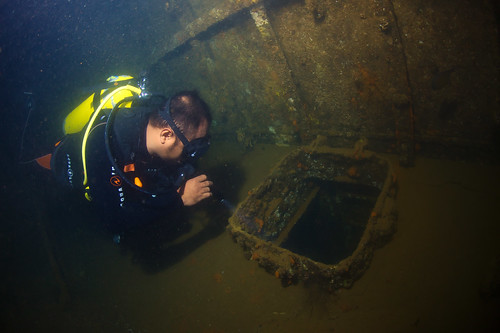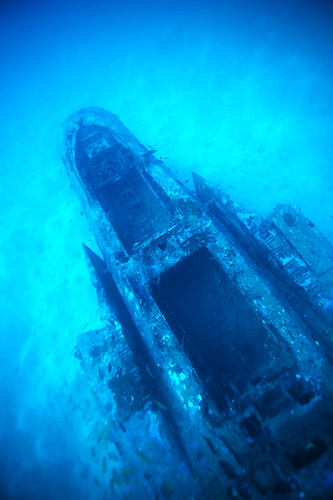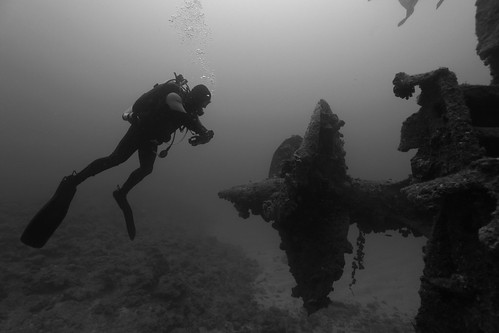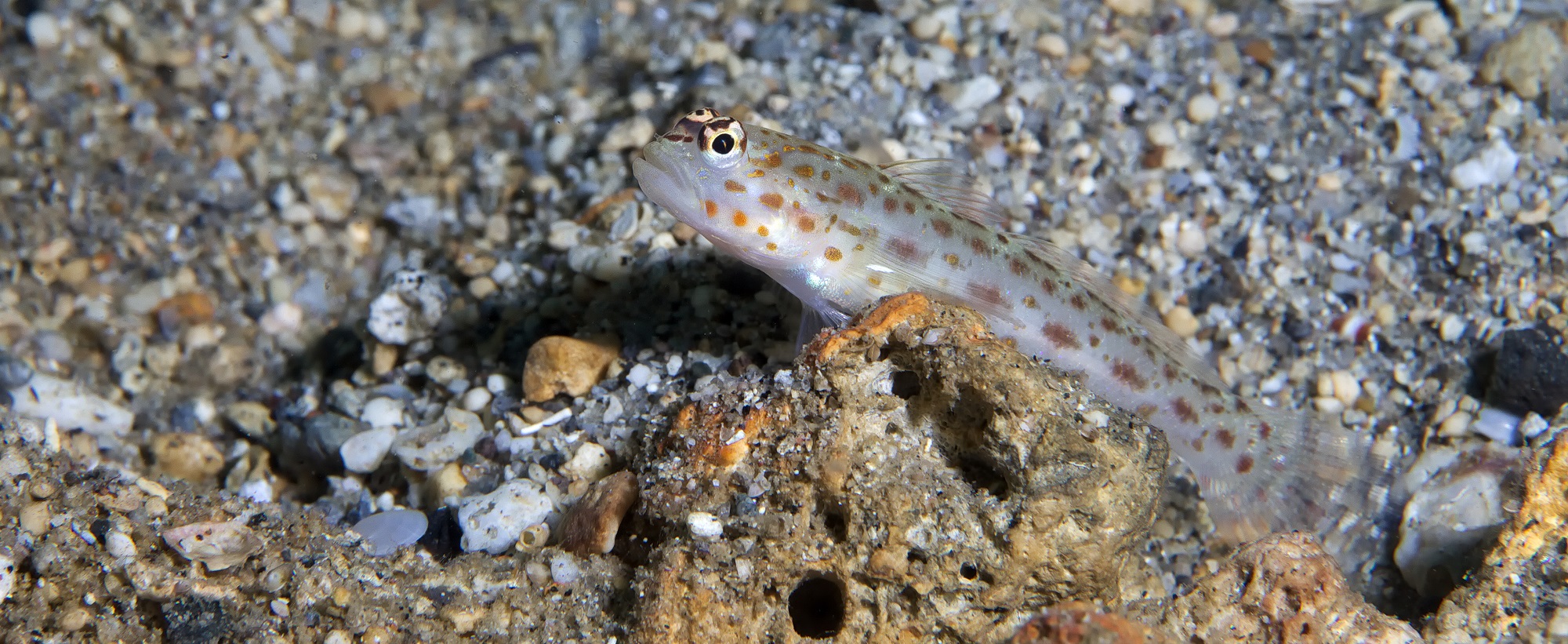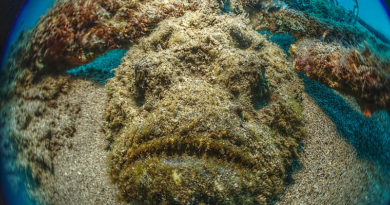The Music Stopped
I wake up early enough so that the tropical sun is only pleasantly warming up Malapascua island, not mercilessly baking it yet. A few hours later into the day, the sand on the beach will be too hot to walk on, but now it feels like a pleasant tickle between my toes. Still half-dreaming I take a few steps towards the nearby dive shop and cafe with the spectacular ocean view. I need to wake up soon, since I plan to go on a serious dive today.
The young woman behind the cafe’s bar welcomes me with her charming Filipino accent, almost singing, “Good mooorning Klaaaus. Cooffeee?”. I return the smile and the greeting, in my more Germanic sounding English, and confirm that caffeine plus sugar is indeed currently my most urgent need. I sit down in one of the chairs set in the sand and ogle – of course not the barista’s chocolate brown arms and shoulders and long black hair – but the distant coastlines of Malapascua’s two neighboring islands: mountainous Leyte to the east and the somewhat flatter Cebu to the south. Perched between these two larger landmasses lies Malapascua like a tiny sandy dot in the deep blue waters of the Visayan sea. Reflecting the morning sun, the flat ocean looks like a massive lake of gold. I will head out there in a few hours, for a dive to a Japanese World War II wreck so deep that it’s out of the range of most scuba divers.
This lovely corner of the world has not always been a holiday destination. In fact it was the site of a fierce naval battle, which turned out to be the beginning of the end of World War II in the Pacific. This battle is named after Leyte gulf, located on the other side of the steep coastal mountain range I am looking at. During a series of engagements in 1944, the US Navy terminally crippled the imperial Japanese naval capabilities. A clever Japanese admiral almost avoided the catastrophic defeat by luring a big part of the US forces away from the main battle, using only a plane carrier empty of fighter planes as a bait. But US naval commanders discovered that they were led astray just in time, and the Japanese occupiers of the Philippines were defeated. The battle of Leyte gulf left a lot of destroyed military hardware on the ocean floor. A lot of it too deep to be explored by divers, but some of it is accessible, even though many of the wrecks’ resting places are deep.
Malapascua island is only at the outskirts of the battle of Leyte gulf, but at least one wreck ended up close to the island. It’s the Mugami Maru which was most likely a submarine-tender, stocking diesel and supplies for submarines with very limited space on-board. When the Mugami sank, it came to rest on a sandy plane about 55 meters (180 feet) deep. This wreck will be the destination of today’s dive. With me are my mates David and Matt, the owners of Evolution Diving on Malapascua. Matt is an Englishman in his 30s who also taught me the techniques involved in deep diving during the last couple of years. Fit and tall, he is serious about his diving, and he better be. As a technical diving instructor, a prudent and careful approach to dive planning and execution keeps him alive.
David is a few years older than Matt and was born and raised on another island – Ireland. His Irish accent is mild, though, and I can understand everything he says during the dive briefing. Over a post-dive beer, David can unleash a witty sense of dark humor, but now he is not in a joking mood as we go over all of our gear configuration and our dive plan.
The dive we are attempting is by no means an easy one. A depth 55 m is at the deeper end of what can safely be dived while breathing air. Any deeper and the life-giver oxygen becomes toxic, so going any deeper should only be done while breathing Helium-containing gas mixes. The other main component of our planet’s atmosphere, nitrogen, also has interesting effects at 55 m: It’s the well-known nitrogen narcosis. Being “narked” as it is called in diver’s jargon is an inebriated feeling not unlike a mix between tipsiness and a laughing gas buzz, with a tad of paranoia sprinkled on top – not too unpleasant in principle, but problematic for a diver who has to concentrate on safe diving procedures in a potentially dangerous environment. And there are indeed ample things we must do right to survive our planned dive.
Due to the depth, this dive is called a technical dive, involving an increased amount of planning and gear. We have a precise plan for our ascent at the end of the dive, for how many minutes we will stop at which depths on our way up, and what we would do if something goes wrong. And instead of the usual single tank like most recreational divers have, we will bring 2 gas cylinders on our backs and 2 more clipped to our left sides. The extra-large serving of compressed air we carry on our backs gives us more time to explore the wreck. The oxygen-enriched air (nitrox) and the pure oxygen slung to our sides will only be used as we breathe on the last part of our ascent to decompress our bodies faster back to surface conditions. Any mistake in switching to these high-oxygen breathing gases too soon can turn fatal within seconds.
Let me very briefly digress here: this is a case where divers actually breathe oxygen! The vast majority of recreational scuba divers breathe air. This does not stop the usual reports in local newspapers reporting on diving accidents from claiming that a diver’s “oxygen ran out”. So whenever you read about a diver breathing oxygen, you can immediately tell that the responsible journalist is as clueless about diving as a desert lizard. This article is of course an exception, as I and my dive buddies are doing an exceptional dive where really, actually breathing oxygen is a part of the dive plan!
We need to get on a boat and ride for about fifteen minutes to reach the site of the wreck. The boat taking us to our dive is the “Haldane”, named after a pioneer researcher of the effects of high pressure on humans. Matt is conferencing with the Haldane’s captain, often eyeing the GPS in his hand. After a few turns of the vessel, we are exactly at the right spot and drop our anchor.
All three of us take a few more test breaths from our scuba regulators, sounding like Darth Vader. We then get up and carefully walk to the front of the boat. With four tanks and lots of regulators, dive lights and cameras strapped to our harnesses, we look as exotic but less dignified than any creature featured in Star Wars. We slide our feet into our fins and jump into the warm, clear ocean below us. At our present location, it’s deep enough so that even with the great underwater visibility in the tropics we can’t see anything below us other than an unbounded expanse of deep blue space.
Once in the water we feel another factor increasing the difficulty of the dive we were about to embark on, a significant current. We anticipated this current, and we knew that it would complicate our descent. Simply letting the air out of our buoyancy compensators and dropping down is not an option: During the 55 m drop, the current would take us to a spot far from the wreck we want to explore. Hence, we have to pull ourselves downwards on the boat’s anchor line against a sideward pull by the current. Since I have to use my right hand to hold onto my camera, this amounts to about 50 one-armed chin-ups while floating head-down and breathing air out of a hose. The anchor line is a new, blue synthetic fiber rope which had not been in the water long enough for barnacles and mussels to grow on it. Hence, I manage to do all my pulls down to the wreck without slicing my fingers open – it’s the little things in life which light up your day!
Once our descent puts Matt, David and myself below a depth of about 30 m (100 feet), the outline of the wreck appears. After a few more pulls along the anchor line, we touch down on its upper deck. During the effort to pull myself down to the wreck, I was breathing much harder than I usually breathe during a dive. That also put carbon dioxide in addition to high-pressure nitrogen into my body and brain, and as a consequence I feel quite a bit more narked than I normally would. I start to fiddle with my camera – it’s a high-end digital SLR in a machined aluminum housing, connected to two powerful underwater strobes. There are a lot of buttons on this setup, and only if all the settings on the camera and the strobes are correctly adjusted does it take good pictures. I pride myself in being a competent underwater photographer, and I have done thousands of dives with this setup. Normally I know how to operate it as speedy and well as my toilet flush or my cell phone. But previously I was shooting pictures with the setup during much shallower dives, without an extra exercise on the way down. I wasn’t nearly as narked as I am now. Presently, on the deck of the wreck, I have to slow down and dedicate all of my attention to the little gray buttons sticking out from the solid black camera housing before I find the one which allows me to change my camera’s ISO settings.
While in this day and age, most countries have laws against drunk driving, I am glad that there are none against narked diving. No one has to pass a sobriety test to swim around underwater – yet. In an age of increased government surveillance, I hope I am not giving any law enforcement agencies any ideas!
Besides impairing my cognitive powers, nitrogen narcosis also floods my mind with a calm sense of relaxation. Now shielded from the current by the hull of the wreck, and with a lot of things to see, the really enjoyable part of the dive begins. The superstructures are mostly in tatters as a combined result of the initial hit which sank the ship, and of soaking in corrosive seawater for seventy years.
What immediately strikes me is how overgrown this large man-made artifact is after several decades of rest on the ocean floor. Barely a spot is not covered with animal life. Different species of hard and soft corals joust for wreck space. Colorful sponges encrust the metal poles which stick out from the remains of the Mugami Maru. Types of small, colorful, nob-shaped animals called salps grow in bunches all over the wreck. The tentacles of sea-feathers passively sway back and forth in the current. Clams populate some of the spaces in-between, and an algal film covers the little space left by all these animals. On the wreck’s outer edges, exposed to the strong current which made me breathe myself into a well-narked state on my way down, large sea-fans thrive. These are highly branched soft corals, and they catch lots of plankton by spreading their polyps into the fast-moving water next to the Maru. The animals growing on the Mugami Maru come from very different branches of life’s evolutionary tree but have all evolved similar modes of filtering and feeding on the ocean’s ubiquitous plankton. The whole broken-up vessel resembles a festive bouquet of vibrantly multi-colored marine invertebrates, assembled by the forces of marine ecology.
Only when I peek through the openings into the inner spaces of the sunken warship does the colorful cover disappear, and nothing but a greyish algal film covers the war-wreck’s steel. I now need a dive light to be able to see. With tropical visibility it’s bright enough even at a depth of 55 meters out in the open, but the innards of the wreck are only dimly lit. But even inside the wreck, there are lots to discover. Between some dislodged metal plates hides a cardinalfish with dark lines on its silvery body. These small and shy fish have evolved a unique trick for protecting their fertilized eggs. Until they hatch, the male cardinalfish takes the eggs into his mouth to shield them from all the hungry fish and crabs on the reef or wreck. I spend a minute to observe if the male fish in front of me is an expecting parent, but I can’t see any eggs behind this one’s teeth.
Back on the deck of the wreck, only a glass plate belonging to a signaling lamp reminds me that I am exploring a human artifact. Next to the lamp, tiny blennies dart back and forth between two coral fingers an arm’s length apart when disturbed by what must appear to them like a Zeppelin-sized giant, myself. A crab dashes sideways out of David’s way to hide in a crevice. A few fin-kicks further towards the stern, a scorpionfish rests on deck, blending in with the rich invertebrate cover. The size of a large cat, this venomous fish is surprisingly easy to overlook, which can lead to a painful surprise for a diver pierced by its fin-spines. When the three of us approach, the big fish sluggishly swims up and re-settles in another spot halfway across the wreck. The deck of the Mugami Maru is truly the theater stage for it’s resident animal ensemble.
In contrast, when I look over the edge of the wreck, I see a barren sandy area with only the occasional small coral-covered rock, populated by a handful of fish. These damselfish and wrasses are struggling in the current, just like I did a few minutes ago. Fish are of course much better swimmers than humans, but if the current is powerful and the fish are small, even they get in trouble too.
The biodiversity-connoisseur knows that tropical submarine sand is far from lifeless: A number of very interesting, exceedingly hard to spot and specialized animals make it their home. But the species numbers and the density of living things are undoubtedly lower in the sand compared to the biodiversity-fireworks on the wreck. The wreck acts as a marine-life magnet. Two beneficial effects are at play here: One is that the historic steel provides a solid surface for the larvae of corals, sponges, anemones and many other encrusting invertebrates to settle on. A block of hard coral simply can’t start growing on unstable, shifting sand. The other factor attracting marine life is the three-dimensional structure of wrecks – it gives many smaller animals a chance to hide, not primarily from divers, but from oceanic predators like large wrasses, gropers and sharks.
In fact, artificial structures are so effective at recruiting marine life that fishermen eager for larger catches and dive operators hoping to create an attraction for divers have frequently and successfully resorted to sinking concrete pillars, metal cages and whole scuttled ships.
On our last minutes on the Mugami Maru, I encounter a small group of batfish. These disk-shaped, roughly frisbee-sized fish are smart and curious and are frequently found living on wrecks. They follow us upwards along the anchor line. I’ve had such a batfish escort several times on wreck dives, and one explanation for this curious behavior might be that divers often rip off tasty barnacles or clams from wreck-parts or buoy lines. Many wreck-resident batfish have learned to associate divers with easy meals. I would, however, not put it above the capabilities of these fellow wreck-enthusiasts to simply be curious about the strange creatures which have visited their home for half an hour.
On our ascent, first the wreck disappears from sight and then, at 15 m (50 feet), the batfish leave us. During the dive’s final minutes, we pause for decompression stops, where we breathe the excess nitrogen out of our bodies so that we can safely return to breathing air at normal atmospheric pressures.
Once we return to the surface, we hand our tanks to the muscular boatmen onboard the Haldane and climb up the ladder back onto the deck. After a quick boat ride, we step onto solid land again. The crew unloads our gear, and we rinse the saltwater of our scuba regulators and harnesses. I then rinse off myself and sit down in the same chair where I had my morning coffee a few hours earlier. I order a mango shake to replenish the energy spent underwater.
After such deep dives, the human-centered world on the surface seems a bit meaningless at times. We just witnessed a vessel which sank during the greatest war in human history and is now resting at depths so deep that conventional air acts like a drug. We saw bizarrely formed animals land-bound humans never get to observe in their natural habitats. The questions what to make of this experience and when to return to the wreck go around in my mind. The question whether to get chicken or beef for dinner really pales in comparison. After surfacing it’s often a bit difficult to relate to one’s non-diving contemporaries who freak out over trivialities.
I am reflecting on the Mugami Maru’s crew. The young men who manned this vessel perished when it sank. I don’t know their names. I can only speculate if they were feverish supporters of the murderous ideology of imperial Japan or coerced into serving its all-out war effort. I don’t know how old they were when they sank with their ship, and if they left young families behind. Did they have good business opportunities lined up for the time after the war, or were they expecting to go back to menial jobs? I don’t know, but I do know that first and foremost they were fellow human beings – with friendships, food, drink and music they enjoyed.
David, with his hair still wet from the post-dive shower, rushes around in his dive shop, asking the boat crew and the dive guides about the scheduled dives for the next day. He sees me with my feet in the sand and my gaze directed oceanwards and points to a frame mounted on the wall to my left. “Have you seen that one?” he asks. Mounted on the dive-shop’s wall is a vinyl record found on the wreck by Matt and David during their previous exploration of the Mugami Maru.
The perished sailors had loved music so much that they brought a small record collection and a record player with them on their deployment. When Matt and David recovered the records, the vinyl ridges had long melted, and all information about the music they once contained had been eaten away by the demons of entropy. The records’ labels were still readable though, and with the help of a Japanese friend, they figured out that it had contained songs by Michi Yakko, a geisha singer famous in Japan at the time, and after the war. Ms. Yakko’s songs were apparently particularly popular at the annual Obon festival, when the Japanese commemorate their ancestors. In a sad ironic twist, given where these copies of her records ended up, Obon is also a time when one is supposed to abstain from swimming in the ocean, to avoid disturbing the ancestors’ spirits.
If you have ever been on a historic war ship from that era, you will know that space was sparse on these. To bring a record collection and a clumsy pre-mp3-times player for these records into their crammed cabins shows how serious the Japanese sailors were about their music. I think of myself as a serious music lover as well. So much do I identify with the music I listen to that I have the logo of my favorite band, Motörhead, tattooed between my shoulder blades. Now, hard rocking Motörhead and 1940s Japanese geisha singing are not exactly the same thing. But the enjoyment of music is such a human universal that finding these records is a stark reminder that individuals with aesthetic tastes died on the Mugami Maru, not nameless soldiers.
The sweet voices have fallen silent, but our imaginations still tell us how this piece of vinyl once lightened up the souls of men caught in a world war.
There are probably not many other commonalities between these military men, fighting for the aggressive nationalist expansion of 1940s Japan, and a free-spirited cosmopolitan like myself. But their enthusiasm for music serves as an emotional tie between us. It always leaves me with an uneasy gut-feeling to enjoy myself diving at a war wreck, a site of fellow humans’ suffering and death. The connection via a personal item like these long-molten records makes this especially salient. As on every wreck dive I do, I am torn between feelings of sadness and compassion, and a positive anticipation of experiencing an intriguing historical site which is also a marine life wonderland.
Many thanks to Matt Reed and David Joyce at Evolution Diving in Malapascua for making the dives to the Mugami Maru possible.
Klaus M. Stiefel is a popular science writer, nature photographer, scuba instructor and independent scientist based in the Philippines. Klaus holds a doctorate in zoology from the University of Vienna. In 2016/17 he published, among other things, a chapter in a book about wreck diving in the Philippines (by Stefan Baehr, “Wracktauchen Philippinen”, in German, Hübner Publishers) and “The Camera and the Brain”, a popular science book explaining what brain research can teach the photographer.

